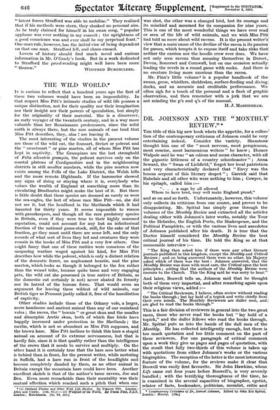THE WILD WORLD.*
IT is curious to reflect that a hundred years ago the first of these two volumes would have been an impossibility. In that respect Miss Pitt's intimate studies of wild life possess a unique distinction, not for their quality nor their imagination nor their insight nor their powers of speculation, but simply for the originality of their material. She is a discoverer, an early voyager of the twentieth century, and in a way more valuable than her Renaissance predecessors, since the solid earth is always there, but the rare animals of our land that Miss Pitt describes, they, alas! are leaving it.
The most interesting of the studies in the present volume are those of the wild cat, the fotunart, fitchet or polecat and the " sweetmart " or pine marten, all of whom Miss Pitt has kept in captivity. The Grampians are the last stronghold of Fells silvestris grampia, the polecat survives only on the coastal plateau of _Cardiganshire and in the neighbouring districts in still smaller numbers, while the pine marten now exists among the Fells of the Lake District, the Welsh hills and the more remote Highlands. If the barometer showed any signs of rising or staying where it is, everybody who values the wealth of England at something more than its _ circulating Bradburies might make the best of it. But there is little doubt that these species are doomed as surely as were the sea-eagles, the last of whose race Miss Pitt—no, she did not see it, but the headland in the Shetlands which it had haunted for thirty years. It seems impossible to reason with gamekeepers, and though all the rare predatory species in Britain, even if they were true to their highly seasoned reputation, could not account for any but an infinitesimal fraction of the national game-stock, still, for the sake of that fraction, go they must until there are none left, and the only records of what sort of lives they led and creatures they were remain in the books of Miss Pitt and a very few others. One might fancy that one of these rarities were conscious of the unsparing warfare waged against his kind, for Miss Pitt describes how while the polecat, which is only a distant relation of the domestic ferret, an unpleasant beastie, and the pine marten, which looks as though it belonged to the fox rather than the weasel tribe, became quite tame and very engaging pets, the wild cat she possessed (a true native of Britain, as the domestic cat certainly is not) never abated its ferocity nor its hatred of the human form. That would seem an argument for leaving these wildest of wild animals, our British tiger as Pennant justly called it, free of the humiliation of captivity.
Other studies include those of the Orkney vole, a larger, more handsome and ancient animal than any of our mainland voles ; the raven, the " bonxie " or great skua and the smaller and dimorphic Arctic skua, both of which fine birds have happily increased under protection in the Shetlands ; the merlin, which is not so abundant as Miss Pitt supposes, and the brown hare. Miss Pitt inclines to think this hare a stupid animal on account of its extreme nervousness, but that is hardly fair, since it is that quality rather than the intelligence of the crows that it needs to survive and multiply. On the other hand it is certainly true that the hare sees better what is behind than in front, for the present writer, while motoring in Suffolk, had a hare run in front of the headlights and become completely dazzled by them, as no other animal in Britain except the mountain hare could have been. Another excellent sketch is that of the author's tame ravens, Joe and Ben. Even more remarkable than their mentality was their mutual affection which reached such a pitch that when one
• (1) Shetland Pirates end Other Wild Life Studies. By Frances Pitt. London: Allen and Unvdn. [10e. 6dj—(2) Wildfots1 of the World, .B.,y Frank Finn, F,Z.S. London : Hutchinson. [4s. Od. net.] was shot, the other was a changed bird, lost its courage and its mischief and mourned for its companion for nine years. This is one of the most wonderful things we have ever readi or seen of the life of wild animals, and we wish Miss Pitt had told us more about wild ravens. It is the present writer's' view that a main-cause of the decline of the raven is its passion for games, which tempts it to expose itself and take risks that neither the carrion nor the hoodie crow ever does. We have not only seen ravens thus amusing themselves in Dorset,. Devon, Somerset and Cornwall, but on one occasion actually, leading the revels in a round game with rooks. And there is I no creature living more uxorious than the raven.
Mr. Finn's little volume is a popular handbook of the t swans, geese, whistlers, sheldrakes, surface-feeding and diving ducks, and an accurate and creditable performance. We often sigh for a touch of the personal and a flash of graphic observation, and then remember with a jerk that we are not minding the p's and q's of the manual.
H. J. MASSINGHAM.


























































 Previous page
Previous page